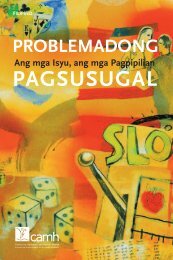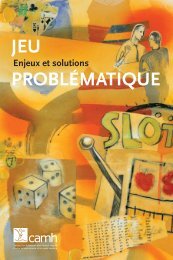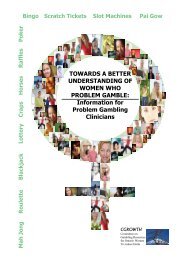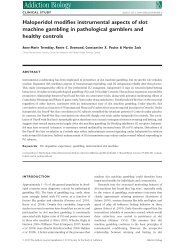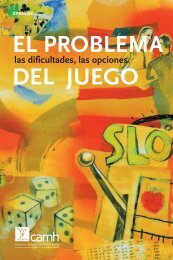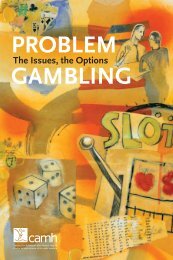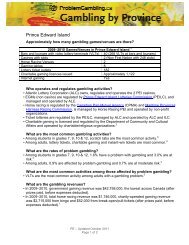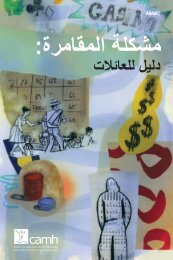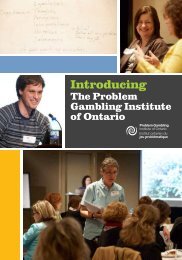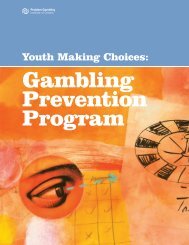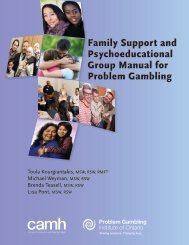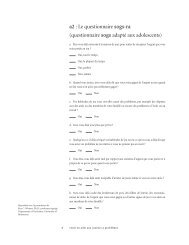Probability, Random Events, and the Mathematics of Gambling
Probability, Random Events, and the Mathematics of Gambling
Probability, Random Events, and the Mathematics of Gambling
Create successful ePaper yourself
Turn your PDF publications into a flip-book with our unique Google optimized e-Paper software.
law <strong>of</strong> averages is <strong>the</strong> error <strong>of</strong> converting <strong>the</strong> correct premise “The number <strong>of</strong> heads <strong>and</strong> tails<br />
even out in <strong>the</strong> long run” to <strong>the</strong> incorrect conclusion “Since <strong>the</strong> number <strong>of</strong> heads <strong>and</strong> tails<br />
even out in <strong>the</strong> long run, I should win if I bet on tails.”<br />
Individuals who gamble <strong>of</strong>ten think that r<strong>and</strong>om events are self-correcting. One possible<br />
reason for this is that <strong>the</strong>ir experience seems to be consistent with this belief. Closely related<br />
to <strong>the</strong> law <strong>of</strong> large numbers is <strong>the</strong> phenomenon <strong>of</strong> “regression to <strong>the</strong> mean,” which predicts<br />
that exceptional outcomes (e.g., very high or very low scores) will most likely be followed by<br />
scores that are closer to <strong>the</strong> mean. For example, a fa<strong>the</strong>r who is very tall is more likely to have<br />
a son who is shorter than he is, not taller. It is true that a tall man is more likely to have a tall<br />
son than a short one, because height is partly under genetic control. However, <strong>the</strong> r<strong>and</strong>om<br />
factors that influence height (<strong>the</strong> recombination <strong>of</strong> <strong>the</strong> parents’ genes, nutrition, accidents,<br />
diseases, etc.) will tend to pull <strong>the</strong> son’s height down closer to <strong>the</strong> average for <strong>the</strong> general<br />
population. The fact is that, by pure chance, <strong>the</strong>re is more room to move down, closer to <strong>the</strong><br />
mean, than up, away from <strong>the</strong> mean.<br />
To turn to a gambling example, suppose a coin is tossed 100 times, <strong>and</strong> 80% are heads. If <strong>the</strong><br />
coin is tossed ano<strong>the</strong>r 100 times, <strong>the</strong> net outcome is more likely to move closer 50% heads<br />
than to stay at 80% heads or to increase to 90%. But it is important to underst<strong>and</strong> that<br />
regression to <strong>the</strong> mean does not have to occur: <strong>the</strong> son could be taller or <strong>the</strong> next 100 flips<br />
could all be heads. But it is more likely that <strong>the</strong> son’s height or <strong>the</strong> number <strong>of</strong> heads <strong>and</strong> tails<br />
will be closer to <strong>the</strong> mean because <strong>the</strong> mean is <strong>the</strong> single most likely outcome. In <strong>the</strong> context<br />
<strong>of</strong> gambling, regression to <strong>the</strong> mean might produce <strong>the</strong> illusion that <strong>the</strong> r<strong>and</strong>om events are<br />
“evening out.” Unusual events (long losing streaks or winning streaks) seem to be corrected<br />
over time, but in fact <strong>the</strong>y are not corrected, only diluted. The average converges towards <strong>the</strong><br />
mean; it is not pushed <strong>the</strong>re. But <strong>the</strong> experience from event to event gives <strong>the</strong> illusion that it is<br />
pushed <strong>the</strong>re by some sort <strong>of</strong> force.<br />
Increased bets may also play a role in convincing those who gamble that r<strong>and</strong>om events are<br />
self-correcting because “chasing” works. Doubling a bet after a loss has <strong>the</strong> interesting effect<br />
<strong>of</strong> increasing <strong>the</strong> player’s chance <strong>of</strong> walking away a winner. The rationale behind this practice<br />
is again <strong>the</strong> law <strong>of</strong> averages. Since people expect r<strong>and</strong>om events to correct <strong>the</strong>mselves,<br />
doubling after a loss may seem like a good investment strategy. Incremental betting strategies<br />
appear to push around r<strong>and</strong>om events so <strong>the</strong>y do not look “r<strong>and</strong>om” (Turner & Horbay,<br />
2003). Turner (1998) has shown that a doubling strategy would be successful if r<strong>and</strong>om<br />
events were self-correcting. The chapter “Games <strong>and</strong> Systems” discusses this betting system<br />
<strong>and</strong> its flaws in more detail. It is enough to note here that most <strong>of</strong> <strong>the</strong> time doubling appears to<br />
work, thus reinforcing <strong>the</strong> idea that r<strong>and</strong>om events correct <strong>the</strong>mselves. This system usually<br />
21




